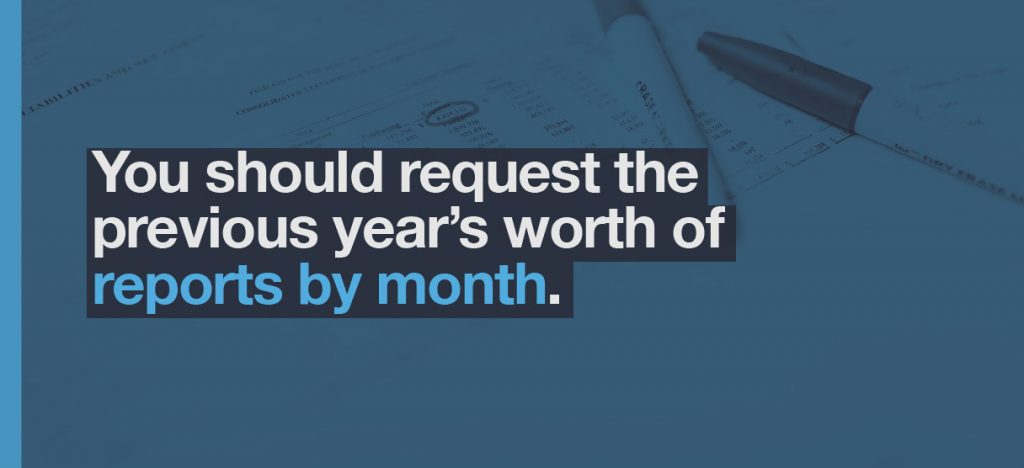- How to read a balance sheet.
- How to read a P&L report.
- How to read a cash flow statement.
- How to make predictions based on these statements.
- How to make informed decisions based on those predictions.
As you embark on the road toward business ownership, many daunting tasks might discourage would-be Acquisition Entrepreneurs from continuing the journey. New obstacles present themselves at nearly every turn.
For example, how do you gauge a business's financial health without all the pertinent information? This is made more difficult by the sheer amount of data you need to pore when analyzing a company.
During the due diligence phase, the checklist of required documents alone is enough to use up the ink in any standard Bic pen – not to mention understanding what those documents tell you.
In this article, we will walk you through some of the basic (but most important) documents you’ll come across while buying a business and teach you the fundamentals required to understand them.
Financial statements are the tools any entrepreneur uses to judge a company’s overall performance. Once you’re able to understand them, you’ll be able to make informed decisions to help you expand the business, improve your profit, and catch any problems before they get out of hand. You should consider the due diligence process an important step in your career, just as much as acquiring and operating a business is a part of your career.
Acquiring a business requires a systematic approach. It takes discipline and work. You should consider the due diligence process an important step in your career, just as much as acquiring and operating a business is a part of your career.
What Are Financial Statements?

Any C-level executive or interested investor would normally concern themselves with three types of financial statements: the profit & loss (P&L) report, the balance sheet, and the cash flow statement. When looking at any of these reports, it’s ideal to compare items over at least two years, preferably more.
To begin with, let’s take a look at the three primary types of statements and what role each one has when doing an analysis of a business.
The P&L Report
The P&L report can also be called the income or operating statement. This report highlights how much income a business generates over a specified period of time and how much profit is left after paying off its costs.
You’ve undoubtedly heard the phrase “give us the bottom line” before. That expression originates in the P&L report: The bottom line shows how much profit a business generates.
The important metrics contained in a P&L report include:
- Gross Profit
- EBITDA
- Operating Expenses
Balance Sheet
The balance sheet is a table that shows all of the resources a business has at its disposal and how they have been financed so far. It itemizes the business’s net assets, the owner or shareholder equity, and the total liabilities.
The balance sheet gives the book value of the business. It is a tally of everything the company owns, owes, and receives investments. It can also be used to determine the business’ rate of return or to appraise its capital structure.
Cash Flow Statement
A cash flow statement looks at how the cash has been handled within a company over a period of time. As we mentioned in a previous article, cash flow refers to the money flowing into and out of a business. It should not be confused with profit.
Cash flow statements are broken down into three different parts:
- Cash flow from operating activities – Cash generated or spent by the regular sale of a company’s goods or services.
- Cash flow from investment activities – Cash generated or spent from buying or selling assets using cash, rather than debt.
- Cash flow from financing activities – Cash generated or spent from debt or equity financing.
Accountants and investors generally want cash flow from operating activities to be greater than the company’s net income. This positive cash flow generally indicates that a business is financially stable and has room for growth.
Why You Need To Learn How To Understand Financial Statements

Undertaking due diligence – and taking it seriously – is the most important aspect of any Acquisition Entrepreneur’s journey. It lets you vet a potential deal and avoid making terrible financial mistakes.
Financial diligence is broken up into two stages.
The first is the pre-LOI (letter of intent) stage. In that phase of the deal, you should aim to:
- Determine whether the business is interesting enough to investigate further.
- Understand the financial trends of the business (revenue growth, expense growth, change in accounts receivable) to determine what types of questions to dig into during deeper diligence.
- Understand any financial risks (seasonality, major customer concentration, etc.).
- Get a basic understanding of the cash cycles of the business – and the company’s habits about handling accounts receivables and payables.
- Review any and all addbacks to ensure they are reasonable.
- Determine whether you are comfortable that the business can operate effectively with its current expenses.
- Brainstorm some opportunities to improve performance.
The 2nd stage is post-LOI financial diligence, which involves:
- Verifying the transactions (bank deposits, payment processor accounts) that make up the financial statements to ensure what you are buying
- Reviewing customer and vendor contracts to ensure payments are in line with the contract terms
- Analyzing the equipment and inventory (assets) that are for sale with the business
- Analyzing business facilities to better understand business operations
- Validating the equipment maintenance costs, insurance costs, and more are in line with expectations and external quotes
- Recreating and forecasting the P&L with any new business changes the buyer is proposing in their growth plan
Each of the tasks described in the above bullet points is made exponentially easier if you grasp the various types of financial reports you will be reading. So, let’s dive into how we actually read each of these reports.
How To Read a P&L Report
A P&L report summarizes the aggregate impact of revenue, gain, expense, and loss transactions over a specified period. The document can derive various financial trends, business activities, and important comparisons over successive periods. You’ll often find P&L reports included with quarterly and annual reports.
Things to look out for on a P&L report include:
Revenue: The amount of money flowing into a business.
Expenses: The amount of money flowing from a business (ie: how much it spends).
Costs of Goods Sold (COGS): The cost of inventory, tools, and equipment necessary to make whatever a business sells.
Gross Profit: Total revenue minus COGS.
Operating Income: Gross profit minus operating expenses.
Income Before Taxes: Operating income minus non-operating expenses.
Net Income: Income before taxes minus taxes.
Earnings Per Share (EPS): Net income divided by the total number of outstanding shares (if a company has issued shares).
Depreciation: How much value a company’s assets have lost over time (ie: aging equipment or outdated software).
EBITDA: Earnings before interest, taxes, deprecation, and amortization.
An example P&L report can be found here.
How To Read a Balance Sheet
The balance sheet displays how much a company has (its assets) and how much it owes (its liabilities). The difference between the two is owners’, or shareholders’, equity.
Things to pay attention to on a balance sheet include:
- What assets does the business own or expect to sell within a given point in time
- Any noncurrent assets that the business considers a long-term investment. These are assets that will not be sold and converted to cash any time soon (i.e.: property rentals). These are usually illiquid and cannot be easily converted into cash.
- Any outstanding debts the business expects to pay within a given point in time.
- Any noncurrent liabilities or financial obligations the business owes but doesn’t need to pay within the next year.
- The statement of owners’ equity is the amount left over if the company were to sell all of its assets and pay off all of its debts. This money belongs to shareholders, whether they are private owners or public investors. It simply depends on the structure of the company.
An example of a balance sheet can be found here.
How To Read a Cash Flow Statement
A cash flow statement helps determine how healthy a business’ cash position is. The statement is split into three segments:
Operating Activities – The cash flow a company generates when it delivers its goods and services. Operating activities include revenue and expenses.
Investment Activities – How much the business has generated by selling assets using real cash, not debt.
Financing Activities – Cash flow generated from debt and equity financing.
There are two ways to calculate a business’s cash flow: direct and indirect.
To calculate the direct method, you begin by adding all of the company’s operating cash collections and then subtracting the cash it paid to fund its operating activities.
The indirect method begins by calculating the company’s net income, which is then adjusted to include expenses and income that have been accrued during a specified time frame but that the company has not paid or received cash for. The indirect method matches cash inflows and outflows to the appropriate time period.
How Do You Analyze A Financial Statement?

There are three ways to analyze the statements mentioned above. When obtaining these documents, you should request the previous year’s worth of reports by month, not just a year-end export from QuickBooks. This will allow you to understand seasonality and identify random, one-off items.
1. Horizontal financial statement analysis. This method involves analyzing the value of line items horizontally over a period of several years. This form of analysis is meant to help identify any factors driving a business's financial performance and help spot any trends.
2. Vertical financial statement analysis. This method helps reveal the vertical effect that a given line item has on other parts of the business. Each line item is assigned a percentage of a base figure within the statement, allowing for a quick overview of how each segment of the business operations has performed. This is useful when comparing results against other periods, competitors, or industries.
3. Ratio financial statement analysis. Accountants use this to determine the statistical relationships between any given line items. Using ratio metrics, the accountant can see how the business performs over time. Once that information is obtained, it’s simple to compare the company’s financials to its competitors using the same equations. Keep in mind that these ratios can be entirely financial (ie: return on assets), or they can be things like gross profit per truck or revenue per technician.
For example, an accountant might want to determine a company's gross profit against its biggest competitor. This is calculated by dividing the company’s profits by its net sales. If the company's gross profits are $800,000 and the competition’s is closer to $100,000, the accountant has a good idea of the business’ overall market success.
Conclusion
It’s not only important to obtain and read these reports, it’s also critical that an Acquisition Entrepreneur understand them. This will help them avoid making bad financial decisions and ensure that the business they acquire is a good investment.
These financial documents can provide valuable insights and help protect you from making mistakes. Those insights can include:
- Any debts the business has and its ability to repay them.
- Profits and loss over a given period.
- Whether the business’ profit has decreased or increased compared to the previous year(s).
- How much investment is required to maintain or grow the business
- The extent of the business’ operational expenses compared to the revenue generated from those same expenses.
Armed with this knowledge, you’ll be able to ensure that you acquire a business worth owning and with the potential for future growth.
Have you had any difficulty understanding financial statements in the past? Let us know your story in the comments below.
If you’re ready to start your own acquisition journey and apply this knowledge, give us a call to learn how to get started.
Key Takeaways
- The P&L report shows how much profit a business has generated.
- The balance sheet gives the book value of the business.
- Cash flow refers to the money flowing into and out of a business.
- A company’s profit is the money left over after expenses are subtracted from revenue.
- Financial diligence is broken up into the pre-LOI stage and the post-LOI stage.
- Amortization and depreciation are both used to indicate how much value any assets have lost over a period of time.
Acquira specializes in seamless business succession and acquisition. We guide entrepreneurs in acquiring businesses and investing in their growth and success. Our focus is on creating a lasting, positive impact for owners, employees, and the community through each transition.



